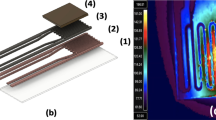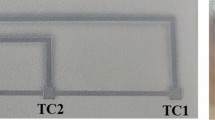Abstract
For some aerospace and automotive applications, it has been difficult to produce instrumentation for the harsh environments encountered. Problems include high temperatures, high centrifugal forces, corrosive exhaust gases, and potential damage from high velocity particulates. This paper reports the design and development of a thin film instrument for temperature monitoring. The device comprises two gold tracks for use as excitation leads, and a platinum resistance element, both applied to a chemically robust electrical insulator. The gold tracks were deposited using a commercial gold ink consisting of a solution of a gold mercapto balsamate complex in an organic solvent. Most of the organic solvent evaporates when the ink is applied, and the residual organic material is removed on fusion. Gold is the metal of choice because of its resistance to oxidation and the chemical and thermal stability of the films produced. Gold ink is particularly easy to apply, the process is readily controlled and no expensive equipment is required. This paper describes the application of the gold ink and the analysis of the films produced, along with a description of the sensor fabrication and performance.
Similar content being viewed by others
References
T.V. Jones, 4th National UK Heat Transfer Conference, Manchester,I. Mech. E. Conf. Trans.,C510/150, 1995, p.1
G.J. Berry, J.A. Cairns and J. Thomson,Sensors and Actuators A, 1995,51, 47
C.S. Pai, B. Zhang, D.M. Scott and S.S. Lau, ‘Materials Research Society Symposium Proceedings, Thin Films and Interfaces II’, ed. J.E.E. Baglin, D.R. Campbell and W.K. Chu, North Holland, 1983,25, 639
G.M. Vest and R.W. Vest,International Journal for Hybrid Microelectronics, 1982,5, 62
R.C. Hendricks and G. McDonald,NASA Technical Reports, NASA-TM-86992, 1985
M. Parkhurst, Engelhard-CLAL (UK) Ltd, personal communication, 1999
‘Application Data for Kodak Photosensitive Resists’, Eastman Kodak Co., 1967
W.K. Chu, J.W. Mayer and M.A. Nicolet, ‘Backscattering Spectrophotometry’, Academic Press, 1978
K.L. Chopra and I. Kaur, ‘Thin Film Device Applications’, Plenum Press, 1983
T.D. McGee, ‘Principles and Methods of Temperature Measurement’, John Wiley and Sons Inc, 1988
Author information
Authors and Affiliations
Additional information
Peter Childs is a Senior Lecturer in the School of Engineering at the University of Sussex. He lectures mechanical design, fluid mechanics and heat transfer. He has interests in air breathing devices ranging from gas turbine and internal combustion engines to medical ventilators. In 1999 he was the winner of the American Society of Engineers — IGTI John P Davis award for exceptional contributions to the literature of gas turbine technology.
Penny Chaloner is a Senior Lecturer in Chemistry at the University of Sussex. She lectures in organic and inorganic chemistry, and occasionally on forensic science and science fiction. Her research interests are in the area of organometallic chemistry, with particular emphasis on catalytic processes using late transition metals that lead to chiral products.
Jo Greenwood is a graduate student in engineering at the University of Sussex. She is working on the development of robust instrumentation for high speed rotating turbomachinery.
Rights and permissions
About this article
Cite this article
Greenwood, J.R., Childs, P.R.N. & Chaloner, P. Gold leads to PRTs for monitoring high temperatures. Gold Bull 32, 85–89 (1999). https://doi.org/10.1007/BF03216615
Received:
Revised:
Issue Date:
DOI: https://doi.org/10.1007/BF03216615




